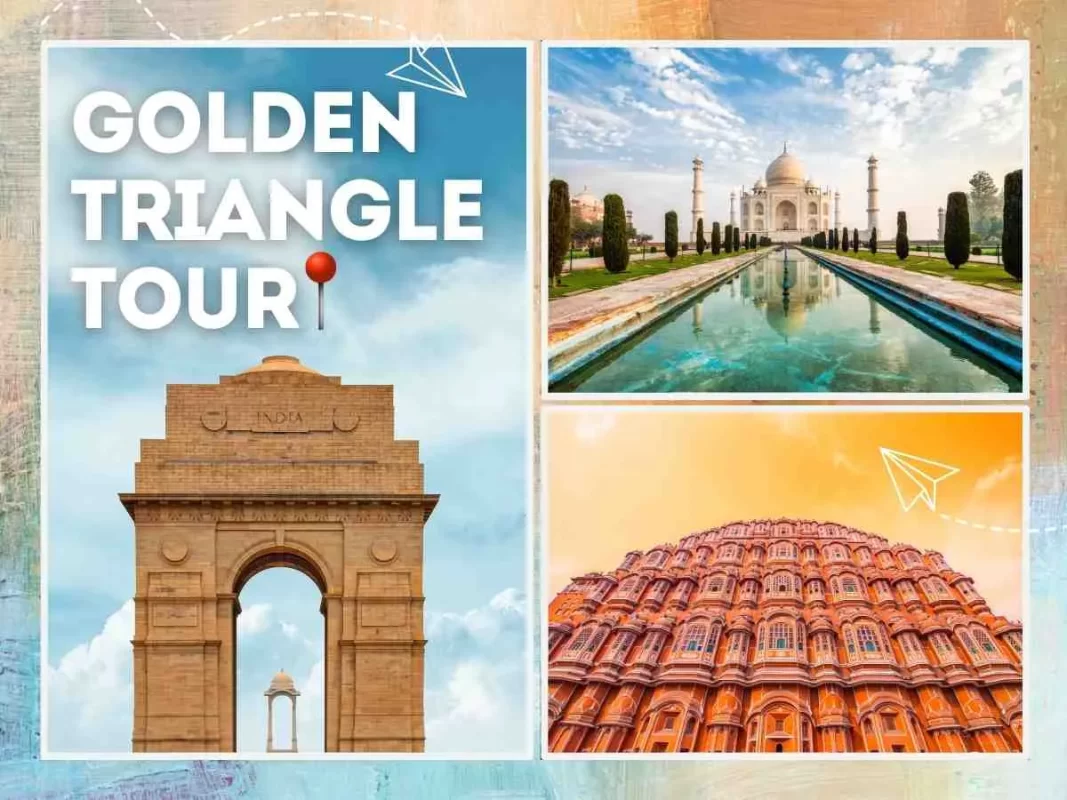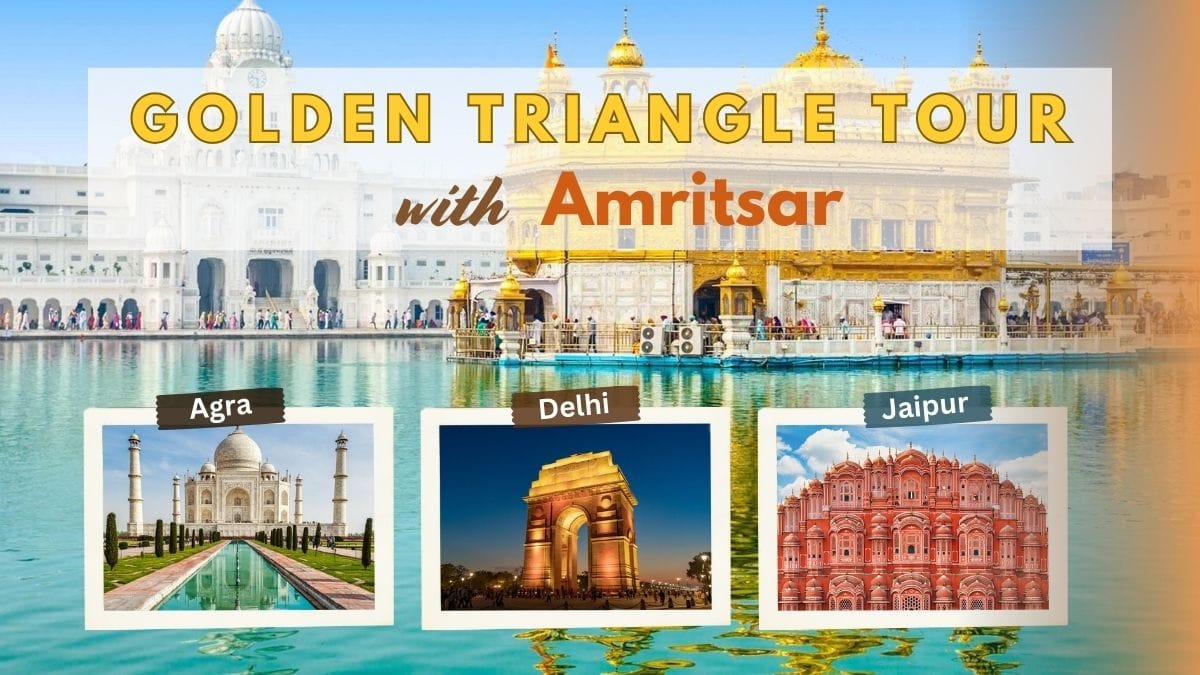India is a country where every nook and corner is unique, astonishing and full of stories and culture. If you want to experience history, culture and spirituality in one go, the Golden Triangle Tour with Amritsar is the way to go. This 7 days guided tour will take you through Delhi, Agra, Jaipur and Amritsar, four cities that have seen so much rise and fall of empires.
This is not just about visiting famous monuments. You will explore the hidden lanes where history still breathes, eat food that carries centuries of tradition and interact with locals who have their own stories to tell. From watching the sunrise over the Taj Mahal to experiencing the emotional energy at Wagah Border, this itinerary will take you through India’s past and present.
Highlights of the Trip
- Walk down the old streets of Old Delhi and see the Mughal architecture also taste the street food.
- See the Wagah Border ceremony
- Visit the Golden Temple and Jalianwala Bagh
- Explore the hidden courtyards of Agra
- Stand in the abandoned city of Fatehpur Sikri
- See the royal heritage of Jaipur through its palaces
- Taste the Mughlai, Rajasthani and Punjabi food
- Buy handicrafts made the ancient way.
A Guide for the 7 Day Tour Plan
This tour is for travellers who want to go beyond the Golden Triangle. By adding Amritsar, you will experience the spiritual heart of Punjab and hear the stories of bravery, sacrifice and faith. The Golden Temple is not just a religious site but a symbol of equality and selfless service. The city also has the weight of history with places like Jallianwala Bagh and the Partition Museum.
Having a guide ensures you don’t miss the hidden gems that make each place special. You will visit temples in Old Delhi which is older than the Red Fort. You will hear the whispers of history in the halls of Agra Fort. You will step into centuries old markets in Jaipur where artisans still work with traditional tools. A guide will help you uncover these layers of history that are often overlooked.
Which Month is Best to Visit the Golden Triangle Tour in India?
October to March is the best time to do this tour as the weather is good for sightseeing. Summers in Delhi and Agra are extremely hot with temperatures crossing 45°C. Jaipur’s desert climate makes afternoons unbearable during these months. Amritsar too gets very hot which makes city exploring tiring.
Suggested Read: An Ultimate Guide for Planning Golden Triangle Tour in India

In winter the temperature in North India drops significantly, Delhi and Amritsar get cold mornings and evenings. This is also the best time to experience local festivals. If you travel in October you can see Diwali celebrations where entire cities are lit up with lamps. If you travel in March you can be a part of the Holi festival. Each season has its own charm but winter provides the best balance of weather and culture.
7 Days Itinerary of Golden Triangle Tour with Amritsar
Day 1: Arriving in Delhi and Travelling to Amritsar
You start in Delhi where you will be greeted by your tour guide. Instead of exploring Delhi on the first day, you will start your Journey with Delhi to Amritsar Tempo Traveller which is a preferred option for a group travelling as it gives a comfortable journey with onboard entertainment and you get the option to stop wherever you want.
On arrival check in to your hotel and relax. In the evening you will visit the Golden Temple, the holiest of all Sikh shrines. The Golden Temple has a unique tradition where the Guru Granth Sahib, the holy book is carried in a grand procession at dawn and night. You will witness this spiritual procession and see how thousands of volunteers prepare langar, the world’s largest free community meal, which feeds over 50,000 people daily.
- What to Eat in Amritsar: Amritsari Kulcha, Dal Makhani, Lassi.
- What to Shop in Amritsar: Phulkari embroidery, Punjabi Juttis, brass utensils.
Day 2: Visit Landmark in Amritsar
Start the day with Jallianwala Bagh as it is a place of the tragic history of India. You will see bullet marks on the walls and the well where people jumped to escape the massacre in 1919. The site is more silent than words.
From here walk to the Partition Museum where you can hear the voices of those who lived through the partition of India in 1947. The museum has personal stories with belongings left behind and letters written by families torn apart.
After lunch go to Wagah Border where the Beating Retreat ceremony takes place every evening. The energy of this event cannot be described but has to be felt. Soldiers from India and Pakistan perform synchronised drills and the crowd on both sides chant patriotic slogans.
Back to Amritsar and visit the local markets. Hall Bazaar is famous for traditional woollen shawls and Amritsari spices. End the day with a traditional Punjabi meal at a local dhaba.
- What to Eat in Amritsar: Sarson da Saag with Makki di Roti, Butter Chicken, Pinni.
- What to Shop in Amritsar: Pashmina shawls, Amritsari pickles, traditional carpets.
Day 3: Travelling Amritsar to Delhi
After breakfast get back to Delhi with a journey of around 10 hours. Upon arrival check into the hotel and take a quick rest. Later take a rickshaw ride through Chandni Chowk which is one of the oldest markets in India. The streets are filled with shops selling silver jewellery, spices and fabrics that have been traded here for centuries. The market was designed by Shahjahan’s daughter and still follows the original layout. In the evening, drive past India Gate and Rashtrapati Bhavan, beautifully lit up at night. Back to the hotel for an overnight stay.
- What to Eat in Delhi: Aloo Chaat, Parathas, Rabri Falooda.
- What to Shop in Delhi: Silver jewellery, handcrafted artefacts, spices from Asia’s largest spice market.
Day 4: Exploring Delhi
Start the day with a guided visit to Humayun’s Tomb a beauty that inspired the Taj Mahal. Unlike other monuments, this one has an underground chamber where the emperor is buried and its Persian gardens are one of the most peaceful places in Delhi.
From here move to one of the largest mosques in India named Jama Masjid. After the mosque take a walk through the hidden lanes of Chandni Chowk where you will find haveli style homes that once belonged to Mughal nobility. You should must try the street foods here.
After lunch visit Qutub Minar. The Iron Pillar in the complex is over 1600 years old and hasn’t rusted. Then visit to Lotus Temple where people of all faiths come to meditate. Unlike other temples, it has no idol or priest.
End the day with a visit to Akshardham Temple which has intricate carvings that tell stories from Indian scriptures and attend the evening light show.
What to Eat in Delhi: Kebab, Nihari, Parathas, Daulat Ki Chaat.
What to Shop in Delhi: Meenakari jewellery, silk sarees, handcrafted pottery.
Day 5: Half Day Delhi Tour and Travel to Agra
Spend the morning at Raj Ghat where Mahatma Gandhi’s eternal flame burns. Then take a short drive to Hauz Khas Village where medieval ruins sit alongside trendy cafes. This was once a major learning centre under the Delhi Sultanate and the ancient structures still have an old world charm.
In the afternoon drive to Agra which will take around 3-4 hours. Upon arrival visit Agra Fort, a palace where the Kohinoor diamond was once housed in the treasury. Here you can see the Pearl Mosque, Diwan-e-am (the hall of public audience) and Diwan-e-Khas (the hall of private audience). From its balconies, you can see the Taj Mahal just as Emperor Shah Jahan did when he was imprisoned here in his last years.
Take an evening walk in Sadar Bazaar where you can find marble handicrafts made using the same techniques as the Taj Mahal’s inlay work.
- What to Eat in Agra: Petha, Bedai Kachori, Mughlai Biryani.
- What to Shop in Agra: Marble inlay souvenirs, Zardozi embroidery, leather goods.
Day 6: Taj Mahal at Sunrise, Fatehpur Sikri, and Jaipur Journey
Wake up early for the sunrise visit to the Taj Mahal at 6 am, it’s a feeling like nothing else. The white marble glows golden and the silence of the morning makes it even more beautiful. Unlike the daytime crowds, you can experience the monument in peace.
After breakfast visit Mehtab Bagh, a garden opposite the Taj Mahal. It’s said that Shah Jahan planned to build a black Taj Mahal here but the plan was never implemented. The site offers one of the best views of the monument. Next, visit Itimad-ud-Daulah, also known as the Baby Taj. It is the first Mughal structure made entirely of marble.
Suggested Read: How Agra Guided Tour can enhance your travel experience
Then drive 36 km to Fatehpur Sikri, a city built by Akbar that was abandoned just 14 years after it was built. Here you will find Buland Darwaza, the tallest gateway in the world and Salim Chishti’s Dargah where people tie threads on marble screens believing their wishes will be granted. In the afternoon drive to Jaipur the capital of Rajasthan. Check into your hotel and relax.
Start the day with an elephant ride to Amber Fort where you can ride up the fort on a cobbled path. Inside you will find Sheesh Mahal a hall made of thousands of mirrors. Even one candle can light up the entire hall. Next visit Jaipur’s hidden stepwells, including Panna Meena Ka Kund which was a secret escape route for the royal family. This is the only stepwell which is symmetrical.
Then visit City Palace where the royal family still resides in one part. You will see antique weapons, royal costumes and the world’s largest silver urns which used to carry holy water for the king’s trip to England.
After lunch visit Hawa Mahal also known as the Palace of Winds. Its unique design allowed royal women to watch street processions without being seen. Visit Johari Bazaar where you can find gemstones that Jaipur has been famous for since the Mughal era.
In the evening drive back to Delhi and end of the tour.
Day 7: Jaipur Sightseeing and Return to Delhi
Start the day with an elephant ride to Amber Fort where you can ride up the fort on a cobbled path. Inside you will find Sheesh Mahal a hall made of thousands of mirrors. Even one candle can light up the entire hall. Next visit Jaipur’s hidden stepwells, including Panna Meena Ka Kund which was a secret escape route for the royal family. This is the only stepwell which is symmetrical.
Then visit City Palace where the royal family still resides in one part. You will see antique weapons, royal costumes and the world’s largest silver urns which used to carry holy water for the king’s trip to England.
After lunch visit Hawa Mahal also known as the Palace of Winds. Its unique design allowed royal women to watch street processions without being seen. Visit Johari Bazaar where you can find gemstones that Jaipur has been famous for since the Mughal era.
In the evening drive back to Delhi and end of the tour.
What to Eat in Jaipur: Pyaz Kachori, Mirchi Bada, Mawa Kachori.
What to Shop in Jaipur: Bandhani sarees, Hand-block printed textiles, Silver jewellery.
How to Get on This Wonderful Trip
If you are travelling to India for the first time or coming to Delhi to explore this wonderful trip, Tempo Traveller Rental in Delhi is luxurious and comfortable option to travel with family or group.

